
S&P 500
Last analysis expected more downwards movement. The target at 2,354 was met and slightly exceeded.
A new wave count is published for members today. The short and mid-term expectation is mostly the same, but this wave count has a better look at the monthly chart level.
Summary: It does not look like a low is in place yet. Expect price to continue falling.
The short-term target for a multi-day to multi-week interruption to the downwards trend is now 2,318.
The target for this large pullback to end is now at either 2,269 or 2,242.
Overall, this strong downwards movement is still expected to be a large correction within an ongoing bull market, which needs one final all time high next year.
The biggest picture, Grand Super Cycle analysis, is here.
The monthly chart will be reviewed again today.
MAIN ELLIOTT WAVE COUNT
MONTHLY CHART
Super Cycle wave (IV) completed a 8.5 year correction. Thereafter, a bull market began for Super Cycle wave (V). The structure of Super Cycle wave (V) is incomplete. It is subdividing as an impulse.
Labelling within Super Cycle wave (V) is now changed. This labelling fits with MACD. Super Cycle wave (V) is still seen as a five wave impulse, and now cycle wave III within it has strongest momentum.
There is still no Fibonacci ratio between cycle waves I and III within Super Cycle wave (V). When cycle wave IV may be complete, then a final target may be calculated at cycle degree. This cannot be done yet. Cycle wave V will be limited to no longer than equality with cycle wave III at 1,130.81 points, so that cycle wave III is not the shortest actionary wave.
A channel is drawn about the impulse of Super Cycle wave (V) using Elliott’s first technique. Cycle wave IV may find support about the lower edge. However, fourth waves are not always contained within a channel drawn using this technique, which is why Elliott developed a second technique. If this channel is breached by downwards movement, then the channel may be redrawn using Elliott’s second technique when cycle wave IV is complete.
There is perfect alternation between a shallow time consuming combination for cycle wave II and now a deeper and most likely more brief zigzag for cycle wave IV. There is excellent proportion so far; cycle wave II was more time consuming, but the speed and depth of cycle wave IV makes these two corrections look like they should be labelled the same degree. This wave count has the right look.
Cycle wave IV may not move into cycle wave I price territory below 2,079.46.
WEEKLY CHART
This weekly chart shows all of cycle waves II, III and IV so far.
Cycle wave II fits as a time consuming double combination: flat – X – zigzag. Combinations tend to be more time consuming corrective structures than zigzags. If cycle wave IV completes as a zigzag, then it should be expected to be more brief than cycle wave II.
Cycle wave IV is now almost at the lower edge of the Elliott channel. It looks like it may breach this channel. That would be acceptable because fourth waves are not always contained within Elliott channels.
Cycle wave IV may not move into cycle wave I price territory below 2,079.46.
DAILY CHART
The daily chart will focus on the structure of cycle wave IV.
So far cycle wave IV looks like it may be subdividing as a zigzag. This would provide perfect alternation with the combination of cycle wave II. Zigzags are the most common corrective structures.
Within this zigzag, primary wave C may be completing as a five wave impulse.
A target is calculated for intermediate wave (3) to end using the most common Fibonacci ratio to intermediate wave (1).
Intermediate wave (2) shows up on the weekly and daily charts. It would be likely that intermediate wave (4) may also show on weekly and daily charts for this wave count to have the right look. Intermediate wave (2) was a deep zigzag lasting six sessions. Given the guideline of alternation intermediate wave (4) may be expected to be a flat, triangle or combination; it would be least likely to be a zigzag.
Intermediate wave (4) may not move into intermediate wave (1) price territory above 2,631.09.
Two targets are calculated for cycle wave IV to end. If price gets to the first target and the structure is incomplete, or if price falls through the first target, then the second target may be used.
When intermediate wave (4) may be complete, then the target may be calculated also at intermediate wave degree. The target may change at that stage.
Keep drawing an acceleration channel about primary wave C. Draw the first trend line from the low of intermediate wave (1) to the latest low, then place a parallel copy on the high of intermediate wave (2). Keep redrawing the channel as price keeps falling. When intermediate wave (3) may be complete, then intermediate wave (4) may find resistance about the upper edge of the channel.
TECHNICAL ANALYSIS
MONTHLY CHART
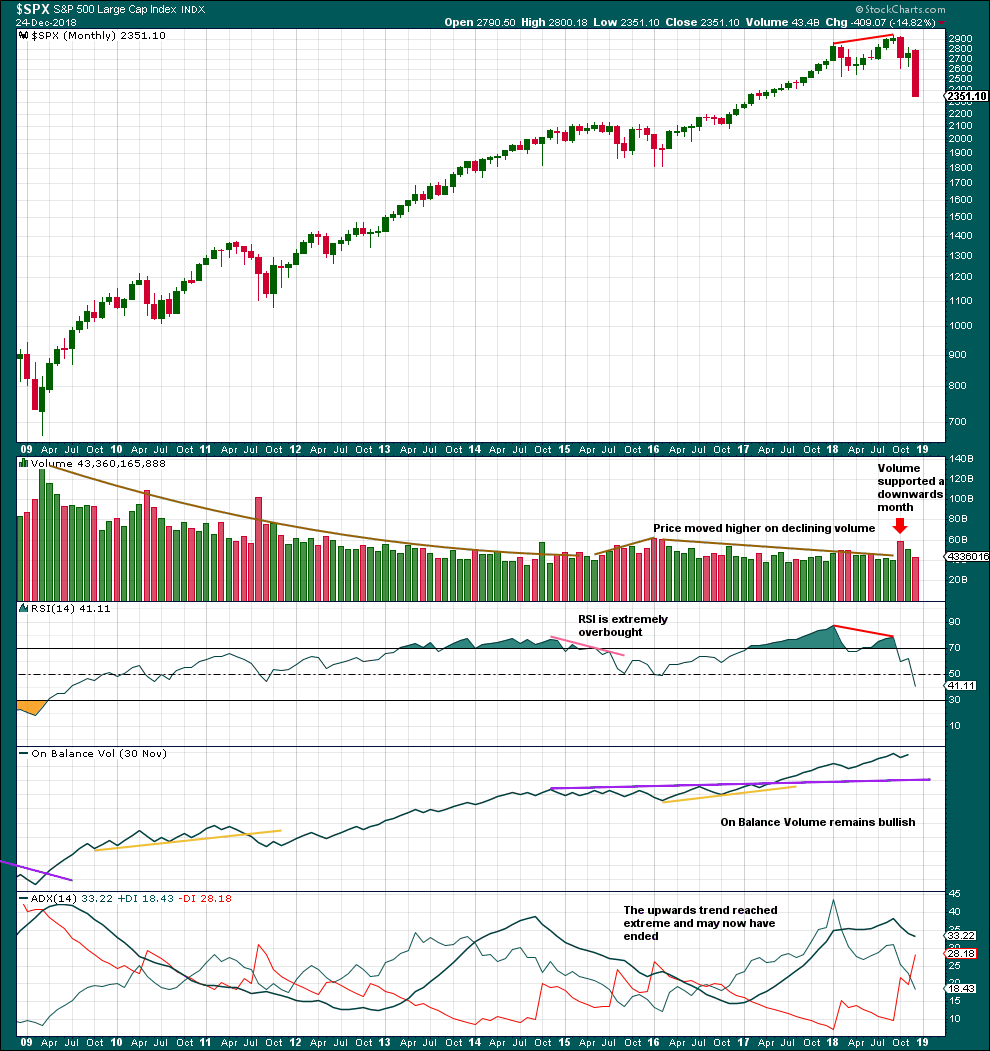
Click chart to enlarge. Chart courtesy of StockCharts.com.
The month of October completed a strong Bearish Engulfing candlestick reversal pattern.
There are two other Bearish Engulfing patterns on this chart: May 2010 and August 2015. Both were followed by more downwards movement that ended between 2 – 5 months later. Both indicated a large correction within the ongoing bull market.
The Bearish Engulfing pattern for October 2018 may indicate another large correction, or it may indicate a change from a long bull market to a fully fledged bear market. It is not possible from candlestick reversal patterns alone to discern which situation may unfold.
WEEKLY CHART
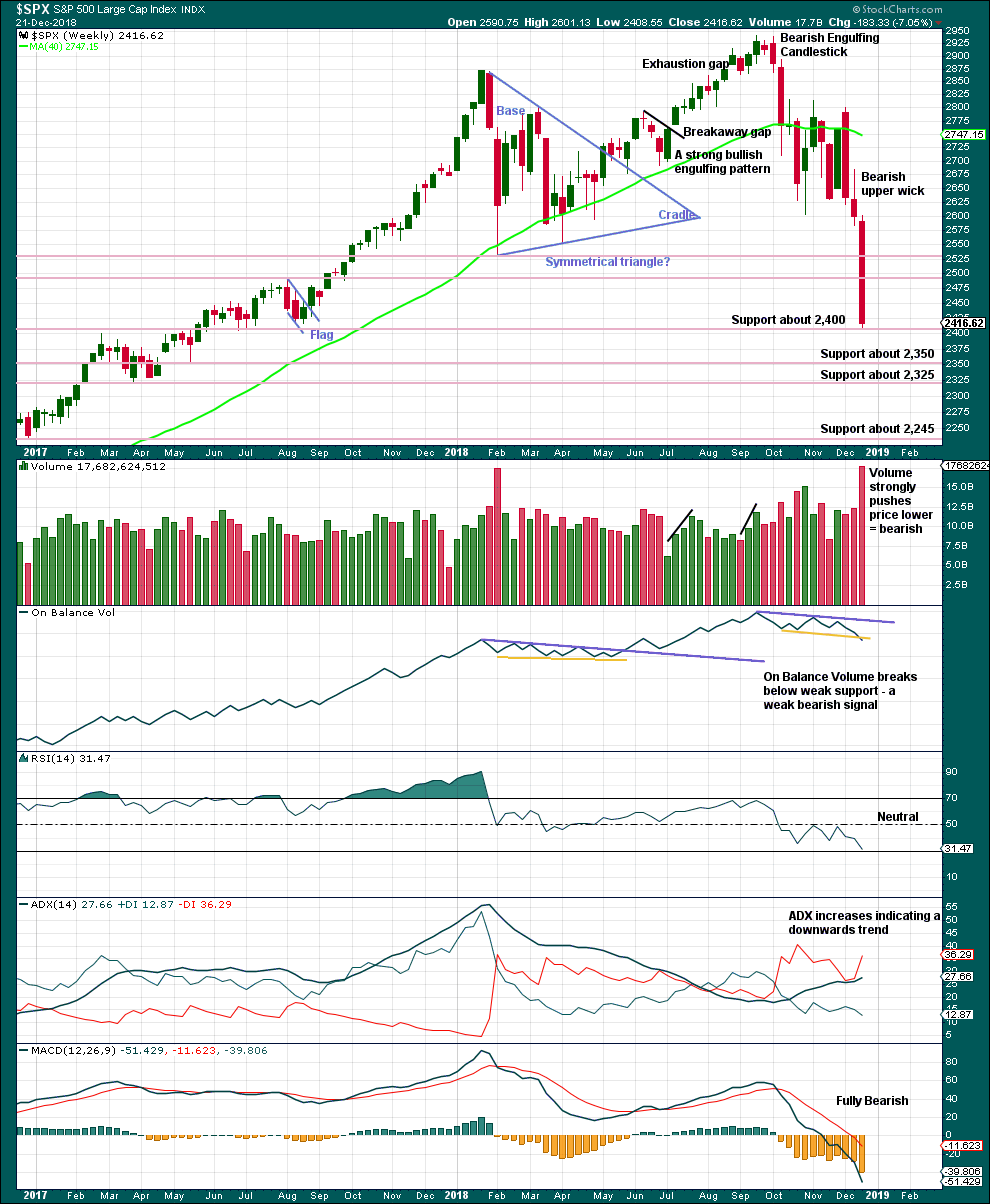
Click chart to enlarge. Chart courtesy of StockCharts.com.
Price has fallen so far 18% from the last all time high.
The last weekly candlestick is very strong indeed. With price closing very close to the low for the week, it looks like more downwards movement may follow this week.
Support lines are identified now on the weekly chart.
This chart is fully bearish.
DAILY CHART
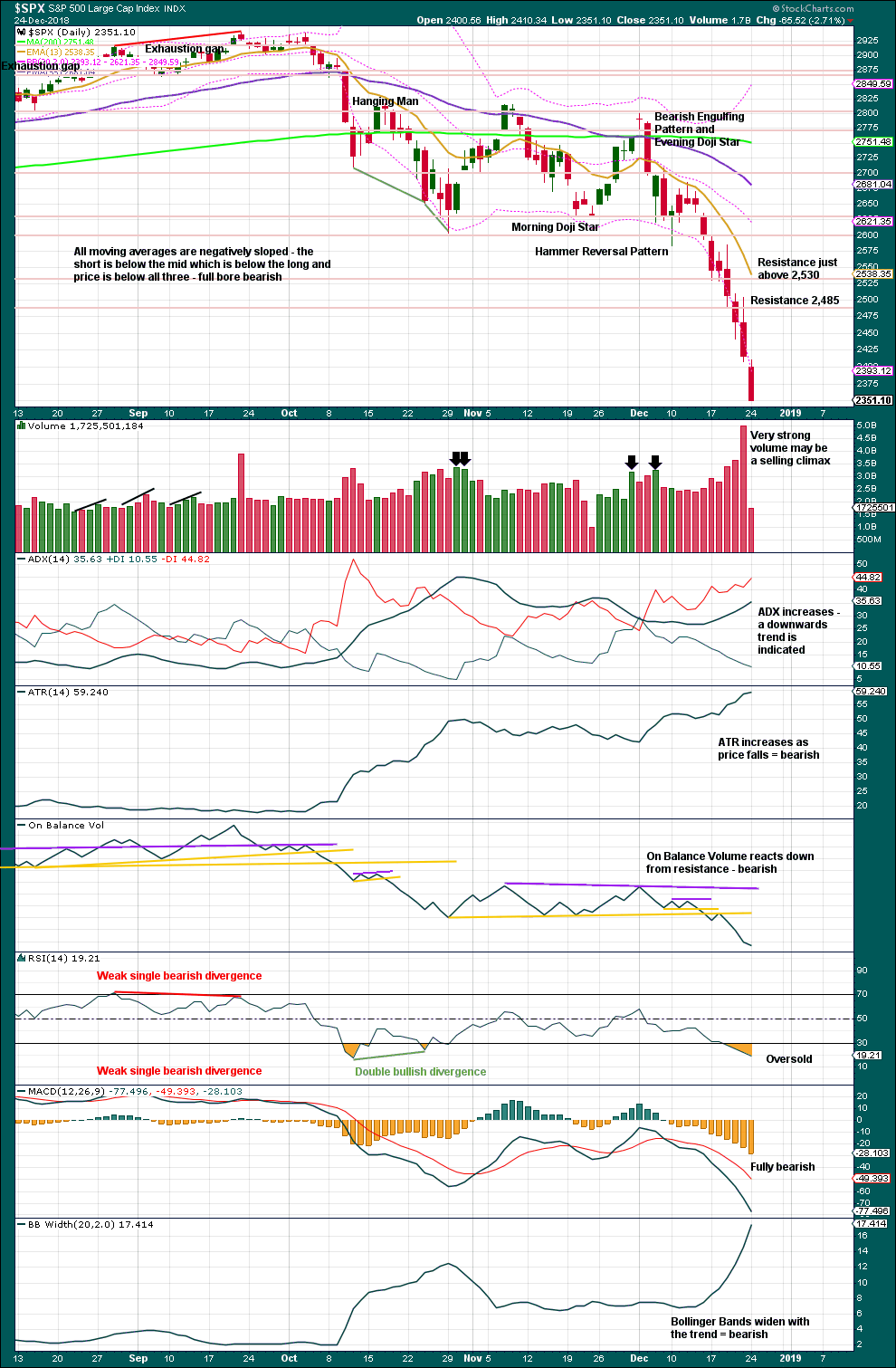
Click chart to enlarge. Chart courtesy of StockCharts.com.
Selling climaxes usually occur close to lows, not at final lows.
Look for a candlestick reversal pattern and / or clear and strong divergence between price and RSI to indicate a potential low. That is still not the case today.
This chart remains fully bearish. With price closing at the low for Monday, expect price to keep falling when markets open after Christmas.
BREADTH – AD LINE
WEEKLY CHART
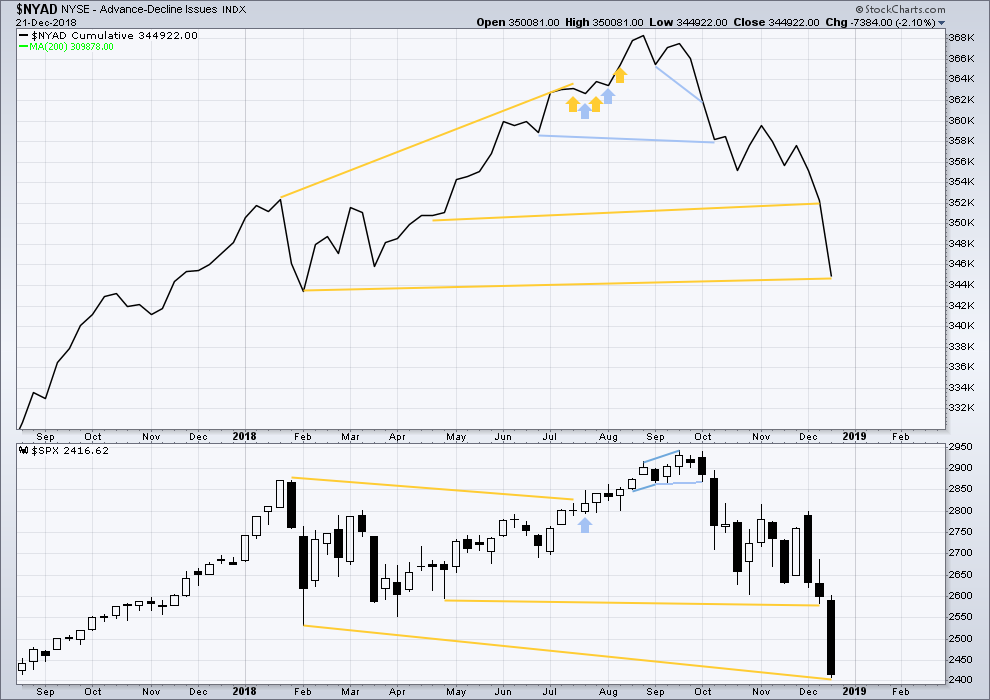
Click chart to enlarge. Chart courtesy of StockCharts.com. So that colour blind members are included, bearish signals
will be noted with blue and bullish signals with yellow.
While price is falling fast, the AD line is not making corresponding new lows. There remains mid-term bullish divergence between price and market breadth.
DAILY CHART
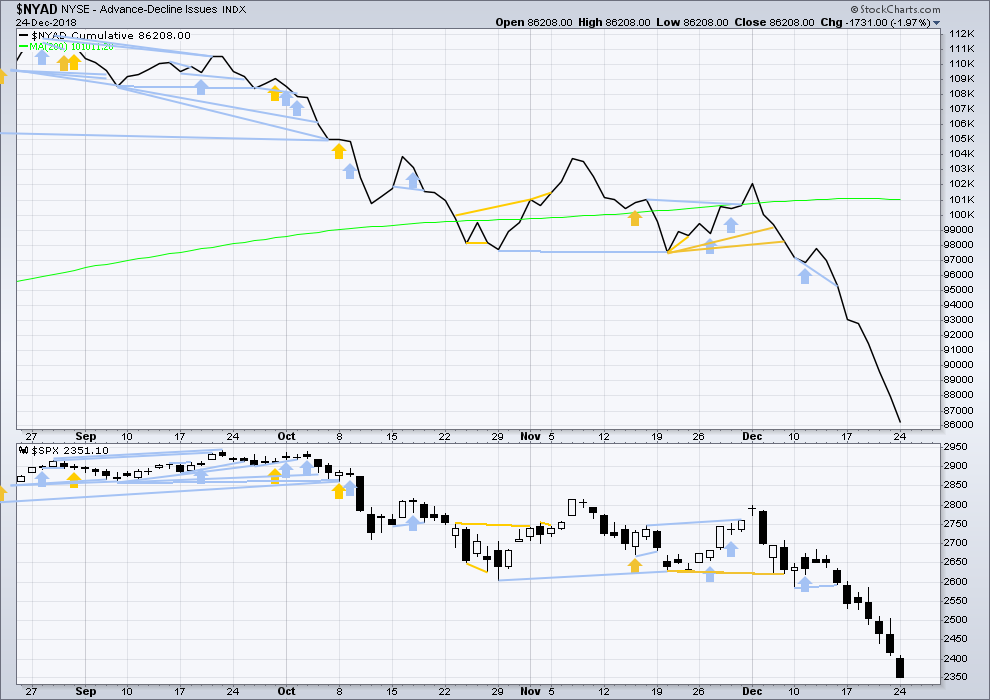
Click chart to enlarge. Chart courtesy of StockCharts.com. So that colour blind members are included, bearish signals
will be noted with blue and bullish signals with yellow.
Breadth should be read as a leading indicator.
For December 24th both price and the AD line have again made new lows. There is no divergence.
SUPPLEMENTAL – AD LINE RECENT HISTORY
This exercise looks at how the AD line behaves prior to a fully fledged bear market and compares that to how it behaves prior to a large pullback within a bull market.
There have been three major pullbacks within the current bull market beginning March 2009:

Click chart to enlarge. Chart courtesy of StockCharts.com. So that colour blind members are included, bearish signals
will be noted with blue and bullish signals with yellow.
The first major pullback from 26th April 2010 to 1st July 2010 saw price fall 17% of market value over 47 sessions.
There was only one day of bearish divergence between price and the AD line at the high on 26th April 2010.
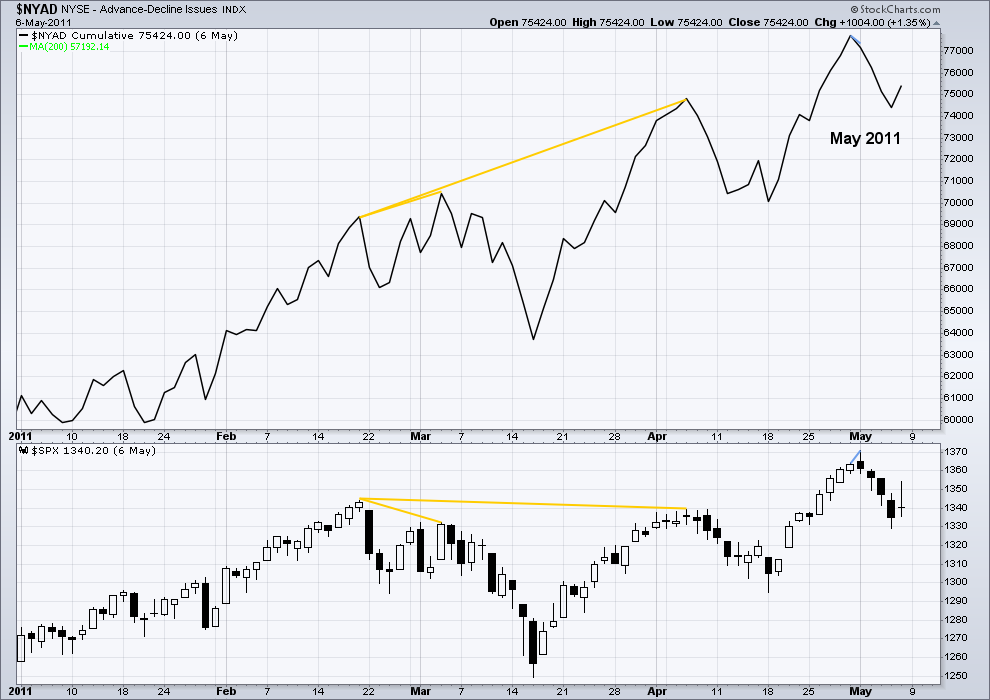
Click chart to enlarge. Chart courtesy of StockCharts.com. So that colour blind members are included, bearish signals
will be noted with blue and bullish signals with yellow.
The next major pullback from 2nd May 2011 to 4th October 2011 saw price fall 22% of market value over 108 sessions.
There was only one day of bearish divergence between price and the AD line at the high on 2011.
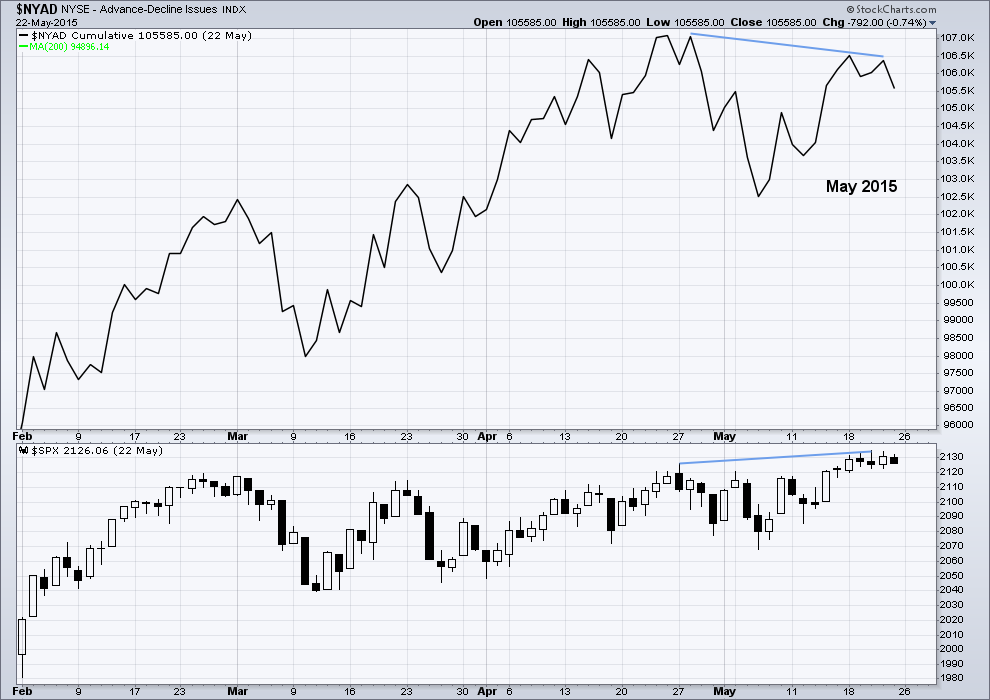
Click chart to enlarge. Chart courtesy of StockCharts.com. So that colour blind members are included, bearish signals
will be noted with blue and bullish signals with yellow.
The third major pullback from 20th May 2015 to 11th February 2016 saw price fall 15% of market value over 184 sessions.
There was only 16 sessions of bearish divergence between price and the AD line at the high on 20th May 2015.
These pullbacks will be compared to the two most recent bear markets beginning March 2000 and October 2007:
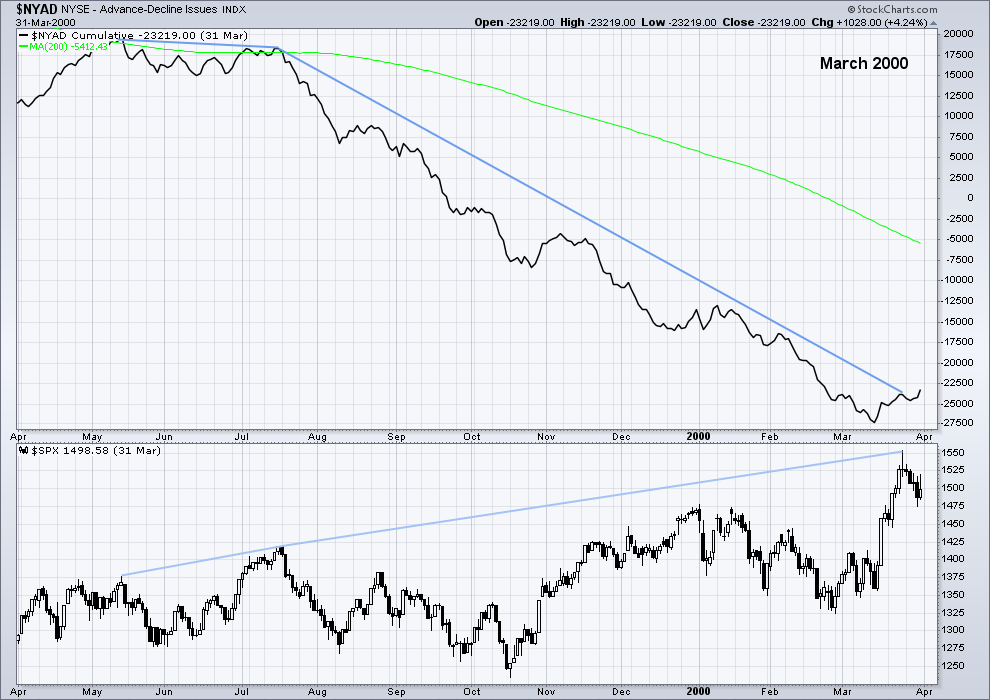
Click chart to enlarge. Chart courtesy of StockCharts.com. So that colour blind members are included, bearish signals
will be noted with blue and bullish signals with yellow.
At the end of the bull market on 24th March 2000, there was bearish divergence between price and the AD line dating back to the 13th May 1999. This divergence is just short of one year in duration.

Click chart to enlarge. Chart courtesy of StockCharts.com. So that colour blind members are included, bearish signals
will be noted with blue and bullish signals with yellow.
At the end of the bull market on 11th October 2007, there was bearish divergence between price and the AD line dating back to 4th June 2007. This was just over 4 months of divergence.
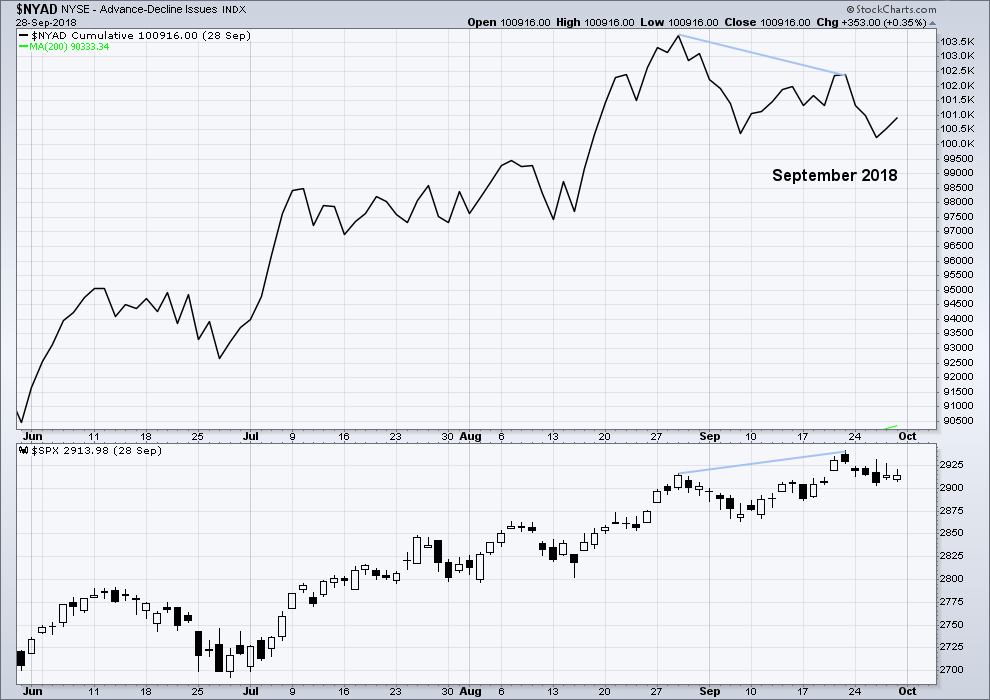
Click chart to enlarge. Chart courtesy of StockCharts.com. So that colour blind members are included, bearish signals
will be noted with blue and bullish signals with yellow.
Finally, a comparison may be made to the current situation.
There was just 16 sessions of bearish divergence between price and the AD line at the last all time high.
This chart is more comparable to the first three charts of pullbacks within a bull market and not to the last two charts of the ends of bull markets and beginning of fully fledged bear markets.
Further, Lowry’s Operating Companies Only AD line shows no divergence between price and breadth at the high of the 21st of September. At that point, there was also no rise in selling pressure as measured by Lowry’s. Normally, selling pressure will show a steady and sustained rise towards the end of a bull market.
In conclusion, I am reasonably confident that the current fall in price will find a low reasonably soon and then be followed by a continuation of the bull market to new all time highs in 2019.
VOLATILITY – INVERTED VIX CHART
WEEKLY CHART

Click chart to enlarge. Chart courtesy of StockCharts.com. So that colour blind members are included, bearish signals
will be noted with blue and bullish signals with yellow.
Bullish divergence noted in last week’s analysis of VIX has disappeared. There is now no divergence as both inverted VIX and price make new lows.
DAILY CHART
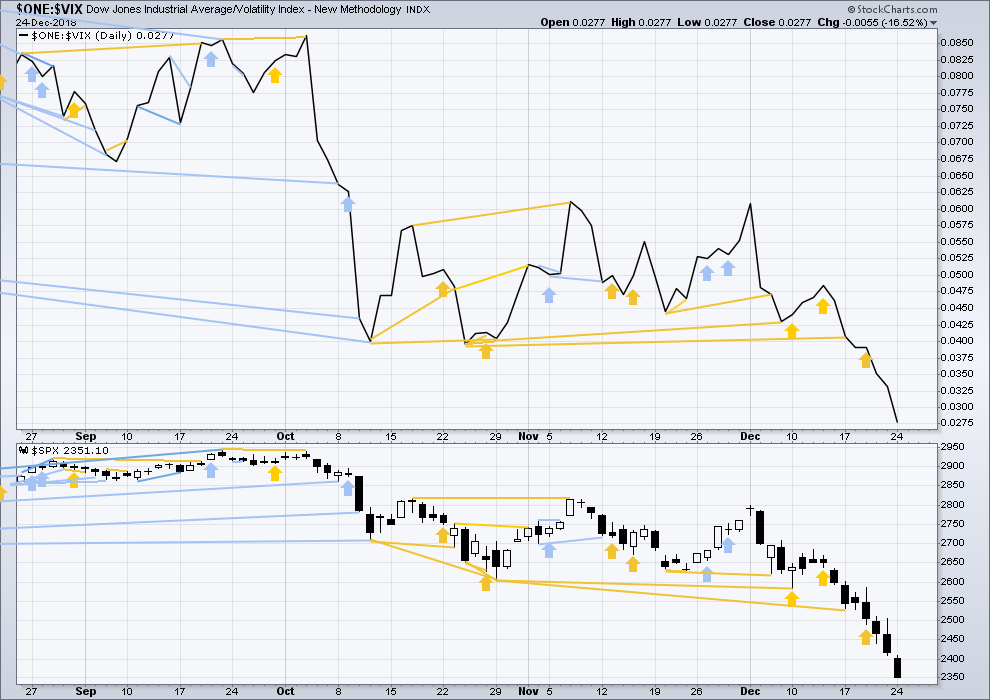
Click chart to enlarge. Chart courtesy of StockCharts.com. So that colour blind members are included, bearish signals
will be noted with blue and bullish signals with yellow.
Both price and inverted VIX have made new lows. There is no divergence.
SUPPLEMENT – DAILY CHART – OCTOBER 2007 TO MARCH 2009
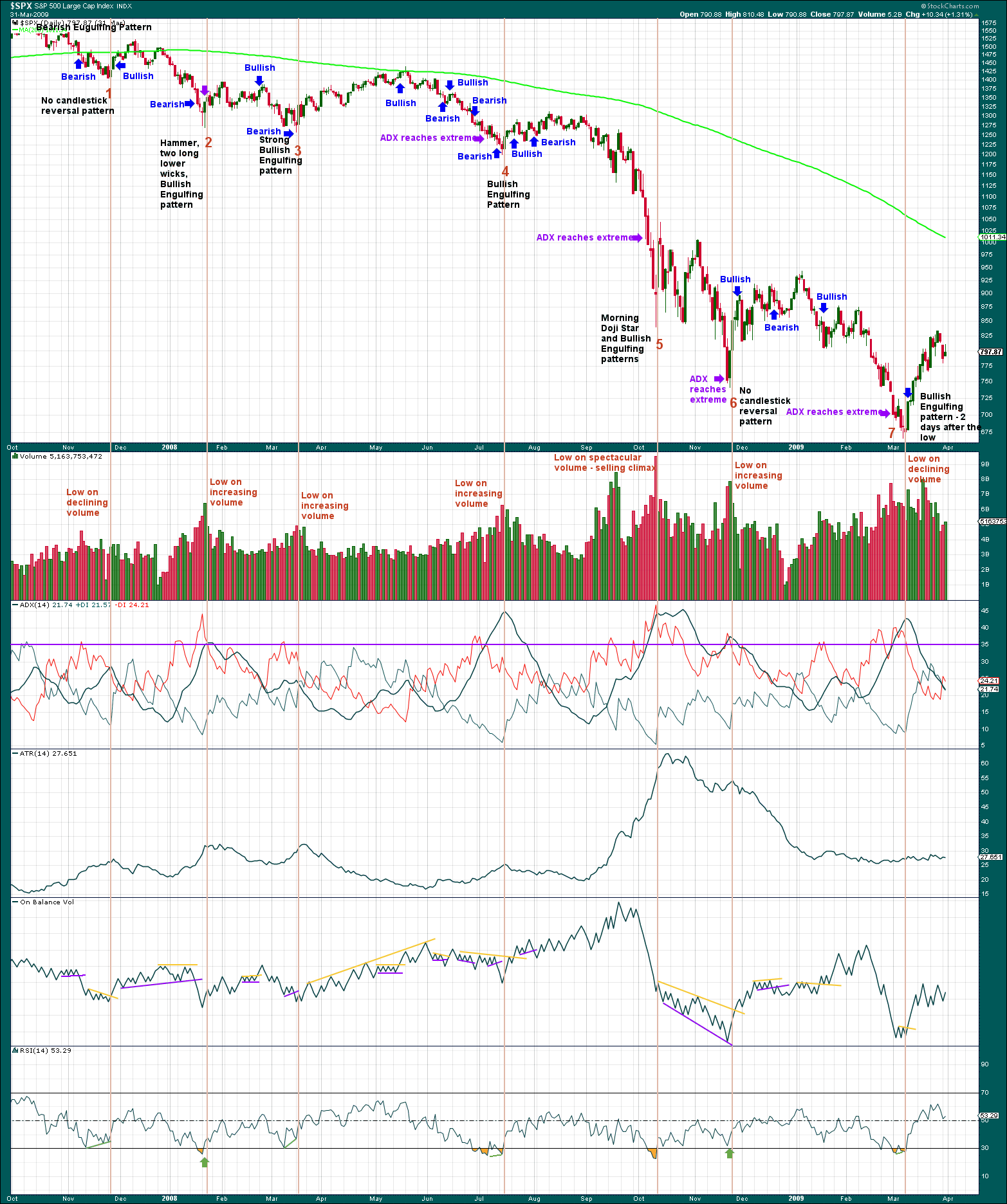
Click chart to enlarge. Chart courtesy of StockCharts.com
This exercise is to determine if there are any signals or a cluster of signals that appeared at minor swing lows and the final low within the most recent bear market from October 2007 to March 2009.
Lows as numbered were characterised by:
1. Declining volume as price fell on the final day, no candlestick reversal pattern, ADX was not extreme. Strong double divergence between price and RSI, but RSI had not reached oversold. A bullish signal from On Balance Volume two days after the low.
2. The day before the low a Hammer pattern (almost a Dragonfly doji but the upper wick is a little too apparent) appeared. The next day a low was found and a Bullish Engulfing pattern completed. Volume increased steadily and markedly to the low. ADX reached extreme just on the day of the low. RSI reached oversold and on the day of the low showed single day bullish divergence.
3. A strong bullish candlestick reversal pattern, and strong divergence with RSI but RSI was not extreme. On Balance Volume gave a bearish signal the day before the low.
4. A candlestick reversal pattern, a strong and steady increase in volume, downwards movement for six sessions after ADX reached very extreme. RSI reached oversold and then exhibited clear divergence with price. On Balance Volume gave a bearish signal two days before the low.
5. A strong bullish candlestick reversal pattern, a spectacular selling climax, ADX reached extreme four sessions prior to the low. RSI reached extreme but exhibited no divergence with price.
6. No candlestick reversal pattern, ADX reached extreme one session before the low, downwards movement had strong support from increasing volume; at the day of the low, there was single day divergence between price and RSI but RSI was not oversold.
7. There was no candlestick reversal pattern (the lower wick was not long enough for a Hammer pattern) at the final low in March 2009. A bullish reversal pattern appeared two sessions after the low. Price fell for the final three sessions on declining volume. ADX reached extreme five sessions prior to the low. On Balance Volume gave a bullish signal two sessions after the low, on the same day as the Bullish Engulfing pattern completed. RSI reached oversold and then exhibited divergence with price.
Additional:
Failed (and partially failed) bearish and bullish candlestick reversal patterns:
14th Feb 2008 – A Bearish Engulfing pattern was followed by only five sessions of downwards movement.
7th May 2008 – A Bearish Engulfing pattern was followed by only two sessions of downwards movement and then a high eight sessions afterwards.
8 Jul 2008 – A Bullish Engulfing pattern was followed by a new low five sessions later.
24th Jul 2008 – A Bearish Engulfing pattern was followed by only two sessions of downwards movement and a new high twelve sessions after.
1 Dec 2008 – A huge Bearish Engulfing pattern was immediately followed by 24 sessions of choppy upwards movement.
20 Feb 2009 – A strong bullish Hammer pattern was followed immediately by downwards movement.
Failed signals from RSI:
3rd Jun 2008 – Price made a slight new swing low and RSI made a slight new swing high. This bullish divergence was slight and RSI was not oversold.
18th Sep 2008 – Single day divergence where price moved lower but RSI moved higher, followed only by one more day of upwards movement.
29th Sep 2008 – Price made a strong new swing low but RSI made a slightly higher swing low, followed by only one day of upwards movement.
3 Oct 2008 – Price made a new low which was not matched by RSI. This bullish divergence was slight and disappeared the following day. It was followed by very strong downwards movement.
13 Nov 2008 – Price made a strong new swing low but RSI was substantially higher. This was followed immediately by very strong downwards movement.
17 Feb 2009 – Price made a new swing low which was not matched by RSI. This bullish divergence disappeared three sessions later and was followed by the final low 13 sessions after.
Volume profile:
Without looking at the price chart, and only looking at volume bars, it is possible to see in what direction price was moving for most of this bear market with a few exceptions. As price moved higher, upwards days exhibited stronger volume than downwards days. The reverse was true as price moved lower. A clear exception was from the 8th to the 18th of Sep 2008, and the 13th of Nov 2008.
Conclusions:
No one indicator or method may be used in isolation.
Strongly rising volume can coincide with a minor or major low. This is also observed by Lowry’s.
Divergence between price and RSI is more reliable when RSI is oversold, or when the divergence is strong. However, even strong divergence can simply disappear.
A cluster of bearish indications at one time increases the probability of a low.
DOW THEORY
Dow Theory confirms a bear market. This does not necessarily mean a bear market at Grand Super Cycle degree though; Dow Theory makes no comment on Elliott wave counts. It may equally as likely mean that Primary wave 4 could be deeper and stronger than originally anticipated.
DJIA: 23,344.52 – a close on the 19th of December at 23,284.97 confirms a bear market.
DJT: 9,806.79 – price has closed below this point on the 13th of December.
S&P500: 2,532.69 – a close on the 19th of December at 2,506.96 provides support to a bear market conclusion.
Nasdaq: 6,630.67 – a close on the 19th of December at 6,618.86 provides support to a bear market conclusion.
—
Always practice good risk management as the most important aspect of trading. Always trade with stops and invest only 1-5% of equity on any one trade. Failure to manage risk is the most common mistake new traders make.

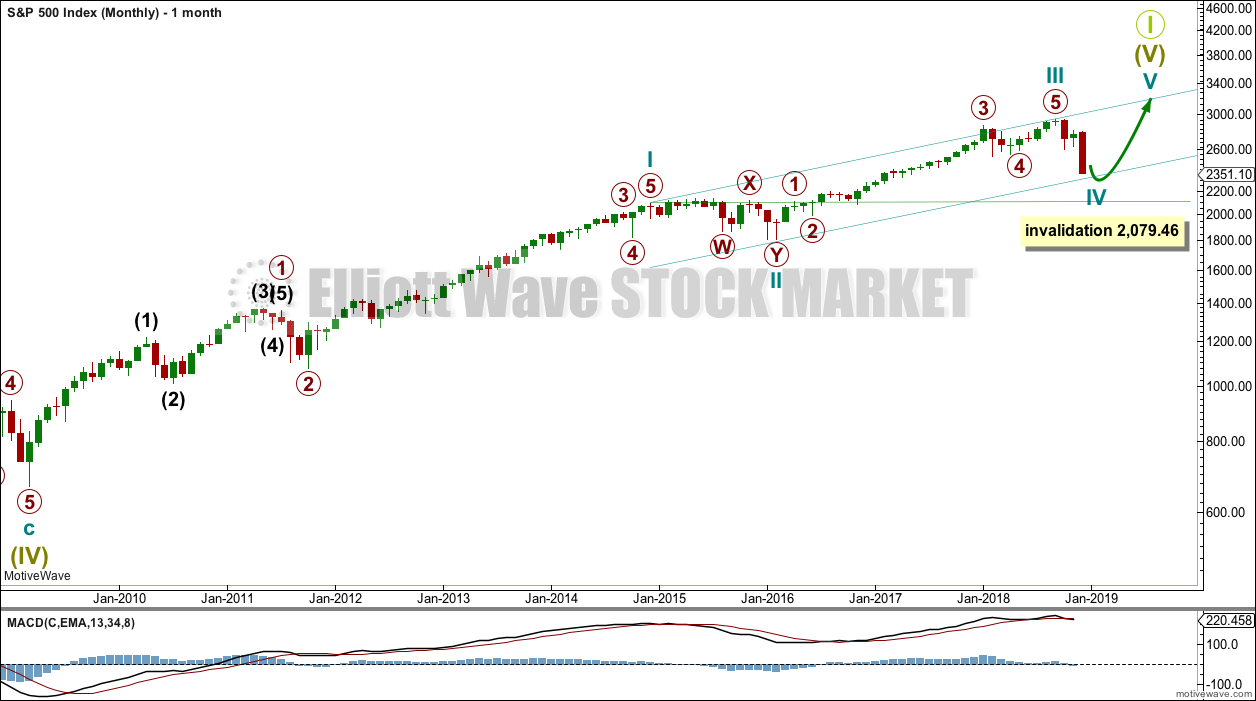
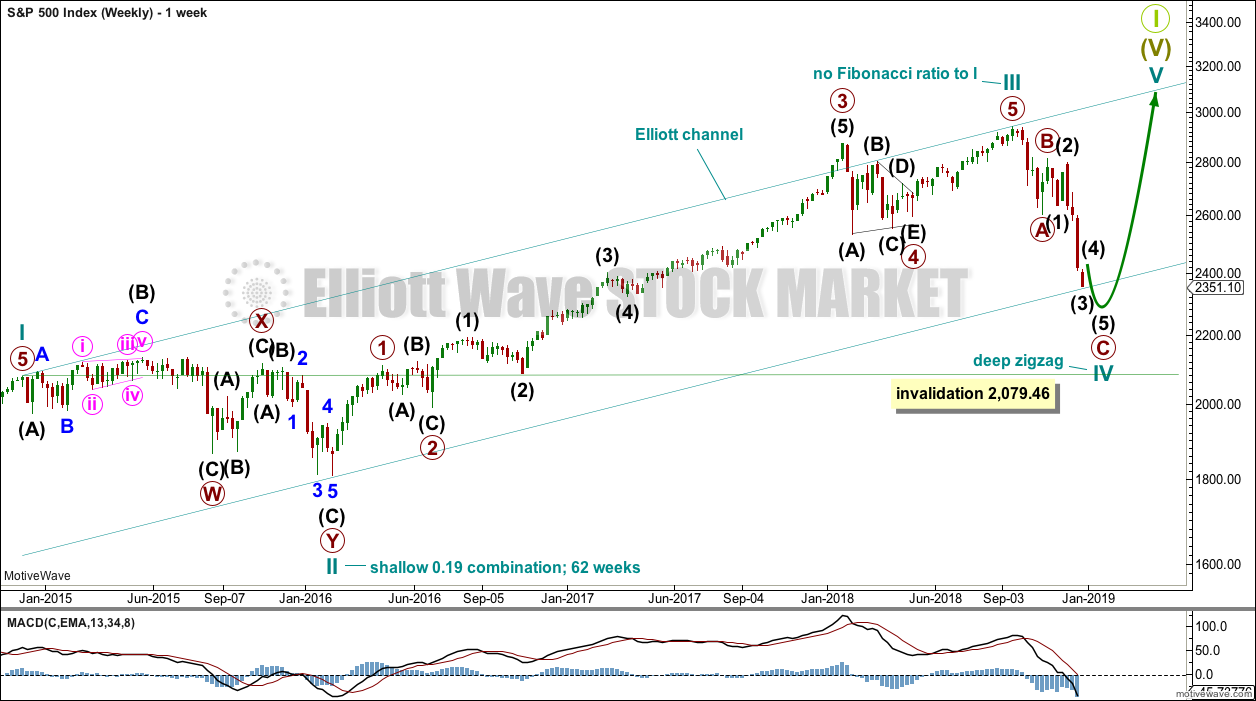
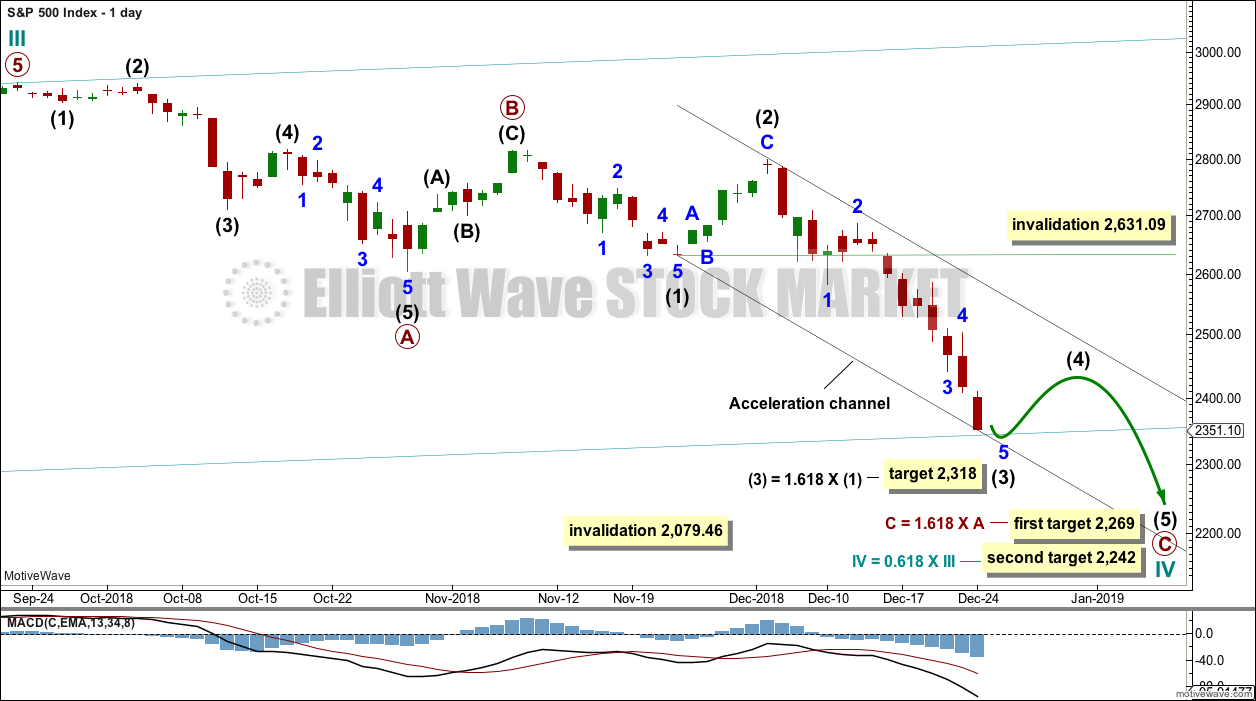
Members please note: this post is an updated intra-week for the S&P500, because the wave count has been changed. My updates and comments here will be for the S&P only.
For any questions / charts / comments on Gold or US Oil, please put those under the last end of week Lara’s Weekly. Thanks.
Update: new alternate wave count for the S&P.
It is possible that a major low was in two sessions ago. The target calculated here is for cycle wave V to = 0.618 X cycle wave III. The target may be met in March or October 2019. These two months seem to be somewhat more common months for bull markets to end.
Hi Lara,
I am so happy !!!…. I went all in, into my favorite stocks on Christmas Eve and I thought it felt like a bottom because of the final flush at the end of the day and I was sure we had a double zigzag….
Today’s action seemed very bullish….
CNBC is calling it the biggest reversal in a decade…
Thanks for the update… I appreciate it…
Mathieu
I’m happy for you too!
Please remember, to manage risk. You must always trade with stops.
Another recommendation, when your positions are positive move stops to breakeven or to protect a little profit.
This allows equity to be freed to add to the position also.
Yes… I do this all the time… I had to do this in December a few times….
Thanks.
Mathieu
Lara
Thanks for the insights as always. In regards to the new wave count, I would have expected minor wave 4 to have lasted longer and because of that we’re still in wave 4. Is there any indicator that you are looking at to give you the impression that we may have started Primary Wave 5?
Thanks in advance for your reply.
Rich
Lara, how do you know that wave 4 is over??? The wave structure confirmed it or some other indicators? Sp is not above 2630 yet to confidently say that the bottom of (C) has been in place… Thanks
Alex
Alex: As presented here, this idea was as an alternate.
Although, I’ve just finished the process of end of week analysis, and this will be my main count now.
If you prefer the idea that cycle wave IV continues lower then you can use the wave count that outlines it.
I will outline all my reasoning in this end of week analysis.
Lara, what about oil? It seems the bottom is miraculously in for oil the same day as for SP?
I published an updated chart on the 26th December for US Oil on the Lara’s Weekly text and chart analysis. I also put it on the US Oil end of week analysis.
This analysis is an update for the S&P only.
For comments and questions on Gold and Oil, please see the last full end of week Lara’s Weekly.
While today’s candlestick doesn’t fully engulf the 24th of December, it does fully engulf the 21st of December. This is a very bullish reversal pattern, with support from volume.
The expectation for the short to mid term is a consolidation or bounce for intermediate wave (4). Most likely target 2,520. To last about one to three weeks.
It may be a very choppy overlapping combination, flat or triangle, most likely.
Merry X’mas Lara!
Would you mind showing the subdivision of wave (3)? I have been trying to replicate your internal count for it and got completely lost. No matter which way I do it I end up with Blue 3 where Blue 5 is… which would mean that (4) becomes Blue 4… I love Elliott Waves and find them so frustrating at the same time! 🙂 Hope you’re having a great time eating lots of Ferreros on your semi-vacation! 🙂
Hi Lara,
For S&P 500:
Thanks for the wave change… I would have thought that Cycle 2 would have been in 2011 and we would have an extended Cycle 3 from 2011 to the top in September of this year…. The correction in 2011 is very similar to the correction this quarter in my opinion…
We made a new low today…. It looks done for wave 3 at least…. Cheers, Mathieu
sorry for intermediate wave 3 (that is)
That would leave the huge correction ending February 2016 at primary degree, lasting much longer than cycle degree corrections.
That does not have the right look.
Yes, the current correction looks similar to the 2011 correction. Probably because they’re both zigzags. Which tend to be sharp relatively brief corrections.
The guideline of alternation tells us to expect cycle waves II and IV to be different.
Understood…. Thanks….
I am still trying to figure out if this correction is a double zigzag… but I am having trouble to fit it…